Abstract
Acivicin is a potent inhibitor of gamma-glutamyl transpeptidase (EC 2.3.2.2), an enzyme of importance in glutathione metabolism. Acivicin inhibition and binding are prevented by gamma-glutamyl substrates and analogs (e.g., serine plus borate), consistent with the previous postulate that acivicin and substrates bind to the same enzyme site. Inactivation of rat kidney transpeptidase by acivicin leads to its binding as an ester to Thr-523. The pig enzyme, which has Ala-523 in place of Thr-523, is inhibited by acivicin with esterification at Ser-405. The human enzyme has Thr-524 (corresponding to Thr-523 in rat); its inactivation leads to esterification of Ser-406 (corresponding to Ser-405 in rat and pig). Hydroxylamine treatment of the acivicin-inactivated enzymes restores activity and releases the acivicin-derived threo-beta-hydroxyglutamate moiety. The findings indicate that there are significant structural differences between the active site region of the rat enzyme and the active site regions of the human and pig. Human mutant enzymes in which Thr-524 and Ser-406 were replaced by Ala, separately and together, are enzymatically active, indicating that these amino acid residues are not required for catalysis. However, esterification of these residues (and of another near the active site) effectively blocks the active site or hinders its function. Acivicin can bind at enzyme sites that are close to that at which gamma-glutamylation occurs; it may bind at the latter site and then be transesterified to another enzyme site.
Full text
PDF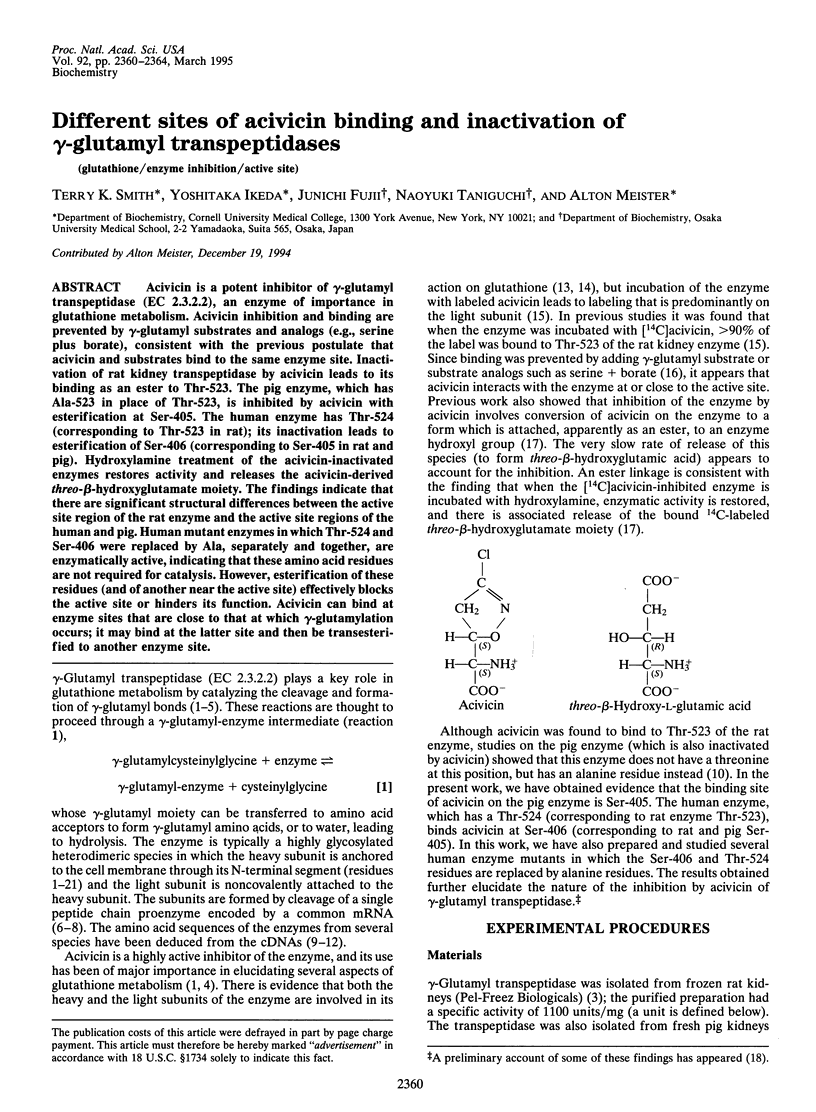
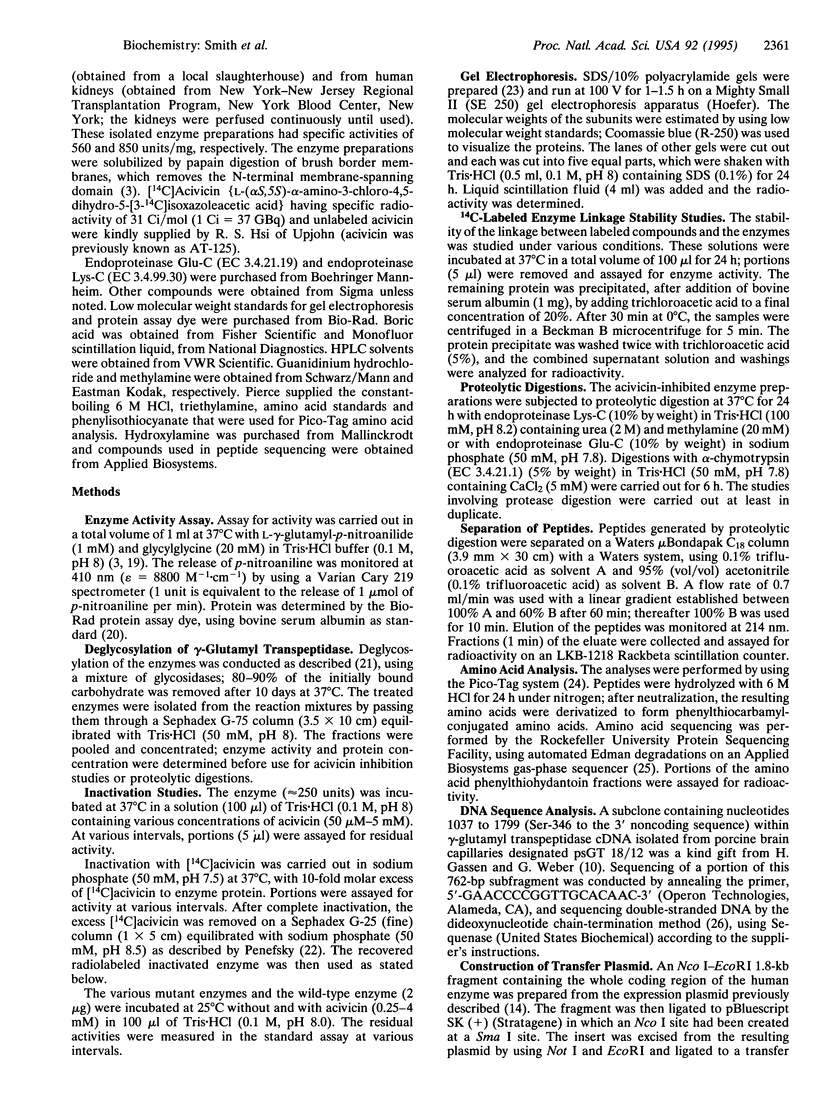
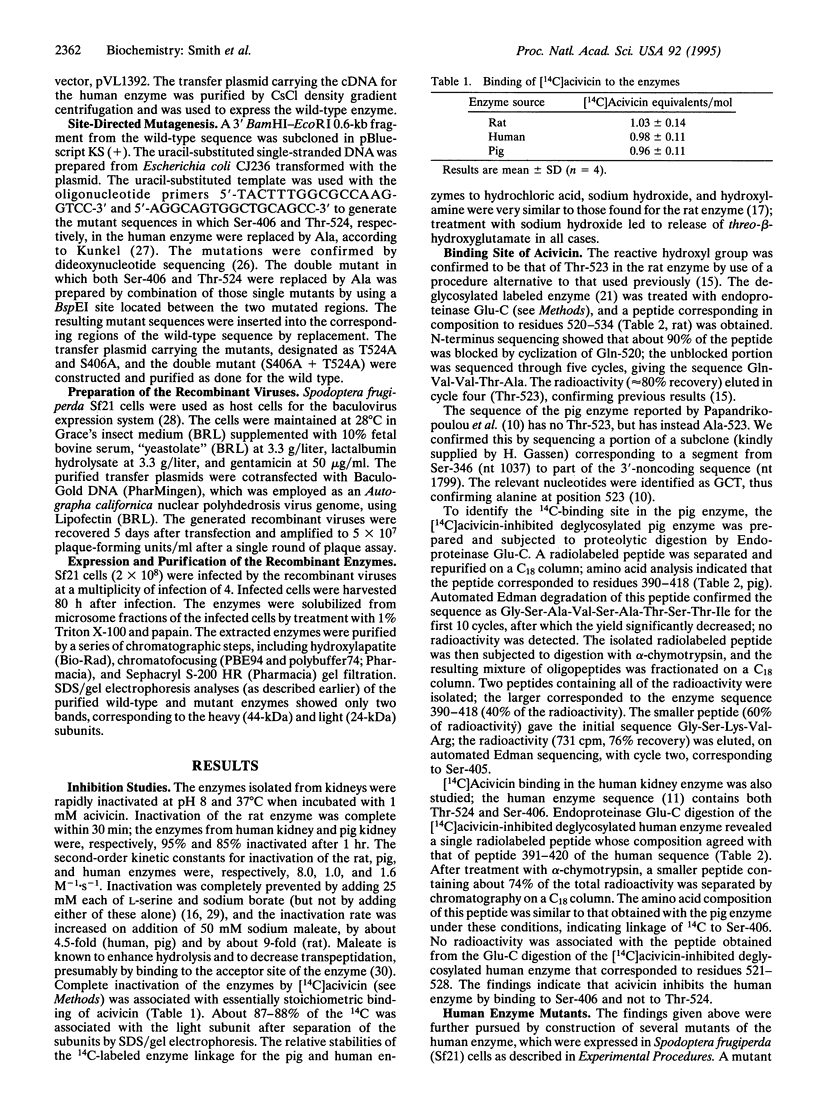
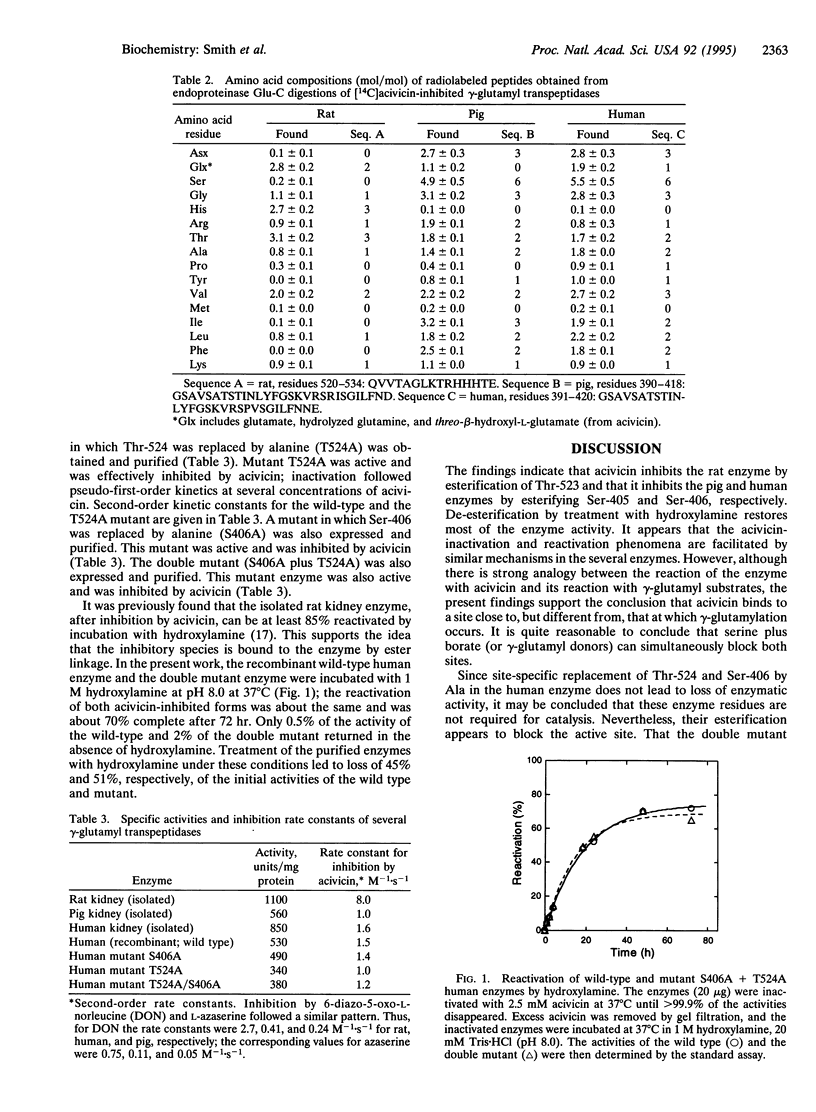
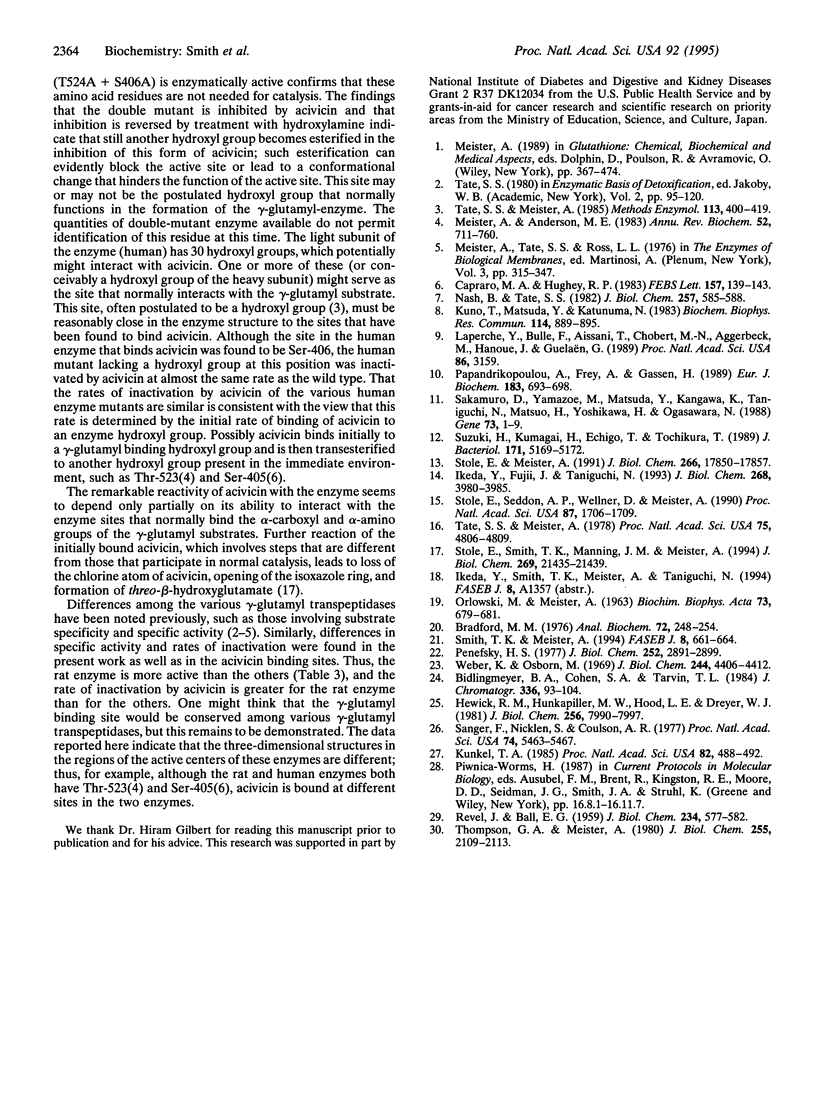
Selected References
These references are in PubMed. This may not be the complete list of references from this article.
- Bidlingmeyer B. A., Cohen S. A., Tarvin T. L. Rapid analysis of amino acids using pre-column derivatization. J Chromatogr. 1984 Dec 7;336(1):93–104. doi: 10.1016/s0378-4347(00)85133-6. [DOI] [PubMed] [Google Scholar]
- Bradford M. M. A rapid and sensitive method for the quantitation of microgram quantities of protein utilizing the principle of protein-dye binding. Anal Biochem. 1976 May 7;72:248–254. doi: 10.1016/0003-2697(76)90527-3. [DOI] [PubMed] [Google Scholar]
- Capraro M. A., Hughey R. P. Processing of the propeptide form of rat renal gamma-glutamyltranspeptidase. FEBS Lett. 1983 Jun 27;157(1):139–143. doi: 10.1016/0014-5793(83)81132-6. [DOI] [PubMed] [Google Scholar]
- Hewick R. M., Hunkapiller M. W., Hood L. E., Dreyer W. J. A gas-liquid solid phase peptide and protein sequenator. J Biol Chem. 1981 Aug 10;256(15):7990–7997. [PubMed] [Google Scholar]
- Ikeda Y., Fujii J., Taniguchi N. Significance of Arg-107 and Glu-108 in the catalytic mechanism of human gamma-glutamyl transpeptidase. Identification by site-directed mutagenesis. J Biol Chem. 1993 Feb 25;268(6):3980–3985. [PubMed] [Google Scholar]
- Kunkel T. A. Rapid and efficient site-specific mutagenesis without phenotypic selection. Proc Natl Acad Sci U S A. 1985 Jan;82(2):488–492. doi: 10.1073/pnas.82.2.488. [DOI] [PMC free article] [PubMed] [Google Scholar]
- Kuno T., Matsuda Y., Katunuma N. The conversion of the precursor form of gamma-glutamyltranspeptidase to its subunit form takes place in brush border membranes. Biochem Biophys Res Commun. 1983 Jul 29;114(2):889–895. doi: 10.1016/0006-291x(83)90864-1. [DOI] [PubMed] [Google Scholar]
- Meister A., Anderson M. E. Glutathione. Annu Rev Biochem. 1983;52:711–760. doi: 10.1146/annurev.bi.52.070183.003431. [DOI] [PubMed] [Google Scholar]
- Nash B., Tate S. S. Biosynthesis of rat renal gamma-glutamyl transpeptidase. Evidence for a common precursor of the two subunits. J Biol Chem. 1982 Jan 25;257(2):585–588. [PubMed] [Google Scholar]
- ORLOWSKI M., MEISTER A. GAMMA-GLUTAMYL-P-NITROANILIDE: A NEW CONVENIENT SUBSTRATE FOR DETERMINATION AND STUDY OF L- AND D-GAMMA-GLUTAMYLTRANSPEPTIDASE ACTIVITIES. Biochim Biophys Acta. 1963 Aug 6;73:679–681. doi: 10.1016/0006-3002(63)90348-2. [DOI] [PubMed] [Google Scholar]
- Papandrikopoulou A., Frey A., Gassen H. G. Cloning and expression of gamma-glutamyl transpeptidase from isolated porcine brain capillaries. Eur J Biochem. 1989 Aug 15;183(3):693–698. doi: 10.1111/j.1432-1033.1989.tb21100.x. [DOI] [PubMed] [Google Scholar]
- Penefsky H. S. Reversible binding of Pi by beef heart mitochondrial adenosine triphosphatase. J Biol Chem. 1977 May 10;252(9):2891–2899. [PubMed] [Google Scholar]
- REVEL J. P., BALL E. G. The reaction of glutathione with amino acids and related compounds as catalyzed by gamma-glutamyl transpeptidase. J Biol Chem. 1959 Mar;234(3):577–582. [PubMed] [Google Scholar]
- Sakamuro D., Yamazoe M., Matsuda Y., Kangawa K., Taniguchi N., Matsuo H., Yoshikawa H., Ogasawara N. The primary structure of human gamma-glutamyl transpeptidase. Gene. 1988 Dec 15;73(1):1–9. doi: 10.1016/0378-1119(88)90307-1. [DOI] [PubMed] [Google Scholar]
- Sanger F., Nicklen S., Coulson A. R. DNA sequencing with chain-terminating inhibitors. Proc Natl Acad Sci U S A. 1977 Dec;74(12):5463–5467. doi: 10.1073/pnas.74.12.5463. [DOI] [PMC free article] [PubMed] [Google Scholar]
- Smith T. K., Meister A. Active deglycosylated mammalian gamma-glutamyl transpeptidase. FASEB J. 1994 Jun;8(9):661–664. doi: 10.1096/fasebj.8.9.7911768. [DOI] [PubMed] [Google Scholar]
- Stole E., Meister A. Interaction of gamma-glutamyl transpeptidase with glutathione involves specific arginine and lysine residues of the heavy subunit. J Biol Chem. 1991 Sep 25;266(27):17850–17857. [PubMed] [Google Scholar]
- Stole E., Seddon A. P., Wellner D., Meister A. Identification of a highly reactive threonine residue at the active site of gamma-glutamyl transpeptidase. Proc Natl Acad Sci U S A. 1990 Mar;87(5):1706–1709. doi: 10.1073/pnas.87.5.1706. [DOI] [PMC free article] [PubMed] [Google Scholar]
- Stole E., Smith T. K., Manning J. M., Meister A. Interaction of gamma-glutamyl transpeptidase with acivicin. J Biol Chem. 1994 Aug 26;269(34):21435–21439. [PubMed] [Google Scholar]
- Suzuki H., Kumagai H., Echigo T., Tochikura T. DNA sequence of the Escherichia coli K-12 gamma-glutamyltranspeptidase gene, ggt. J Bacteriol. 1989 Sep;171(9):5169–5172. doi: 10.1128/jb.171.9.5169-5172.1989. [DOI] [PMC free article] [PubMed] [Google Scholar]
- Tate S. S., Meister A. Serine-borate complex as a transition-state inhibitor of gamma-glutamyl transpeptidase. Proc Natl Acad Sci U S A. 1978 Oct;75(10):4806–4809. doi: 10.1073/pnas.75.10.4806. [DOI] [PMC free article] [PubMed] [Google Scholar]
- Tate S. S., Meister A. gamma-Glutamyl transpeptidase from kidney. Methods Enzymol. 1985;113:400–419. doi: 10.1016/s0076-6879(85)13053-3. [DOI] [PubMed] [Google Scholar]
- Thompson G. A., Meister A. Modulation of gamma-glutamyl transpeptidase activities by hippurate and related compounds. J Biol Chem. 1980 Mar 10;255(5):2109–2113. [PubMed] [Google Scholar]
- Weber K., Osborn M. The reliability of molecular weight determinations by dodecyl sulfate-polyacrylamide gel electrophoresis. J Biol Chem. 1969 Aug 25;244(16):4406–4412. [PubMed] [Google Scholar]


